The Investigation of Gas Distribution Asymmetry Effect on Coriolis Flowmeter Accuracy at Multiphase Metering
Abstract
:1. Introduction
2. Methods
2.1. Investigated Coriolis Flowmeters
2.2. Methodology of Experimental Study of CFM Operation at Multiphase Metering
2.3. Methodology of Computational Study of Gas Distribution Asymmetry in CFM
3. Results
3.1. Validation of Simulation Methodology
3.1.1. Validation of Stratified Flow Regime Simulation Methodology
3.1.2. Validation of Stratified Flow Regime Simulation Methodology
3.1.3. Validation of CFM Tube Oscillation Neglect Assumption
3.2. The Gas Distribution Asymmetry in the CFM Tube at Different Conditions
3.3. The CFM Error Correction Based on the Effect of Gas Distribution Asymmetry
4. Summary
Author Contributions
Funding
Conflicts of Interest
References
- Li, Y.; Chen, H.; Zhang, X.; Tan, C.; Ding, Y. Renewable energy carriers: Hydrogen or liquid air/nitrogen? Appl. Therm. Eng. 2010, 30, 1985–1990. [Google Scholar] [CrossRef] [Green Version]
- Lim, Y.; Al-Atabi, M.; Williams, R. Liquid air as an energy storage. J. Eng. Sci. Technol. 2016, 11, 496–515. [Google Scholar]
- Foss, M. An Overview on Liquefied Natural Gas (LNG), Its Properties, the LNG Industry, and Safety Considerations; The University of Texas at Austin: Austin, TX, USA, 2012. [Google Scholar]
- Green, A.J.; Littlejohn, K.A.; Hooley, P.; Cox, P.W. Formation and stability of food foams and aerated emulsions: Hydrophobins as novel functional ingredients. Curr. Opin. Colloid Interface Sci. 2013, 18, 292–301. [Google Scholar] [CrossRef] [Green Version]
- Kopechek, J.A.; Haworth, K.J.; Radhakrishnan, K.; Huang, S.-L.; Klegerman, M.E.; McPherson, D.D.; Holland, C.K. The impact of bubbles on measurement of drug release from echogenic liposomes. Ultrason. Sonochem. 2013, 20, 1121–1130. [Google Scholar] [CrossRef] [PubMed] [Green Version]
- Postema, M.; Schmitz, G. Ultrasonic bubbles in medicine: Influence of the shell. Ultrason. Sonochem. 2007, 14, 438–444. [Google Scholar] [CrossRef]
- Anklin, M.; Drahm, W.; Rieder, A. Coriolis mass flowmeters: Overview of the current state of the art and latest research. Flow Meas. Instrum. 2006, 17, 317–323. [Google Scholar] [CrossRef]
- Wang, T.; Baker, R. Coriolis flowmeters: A review of developments over the past 20 years, and an assessment of the state of the art and likely future directions. Flow Meas. Instrum. 2014, 40, 99–123. [Google Scholar] [CrossRef] [Green Version]
- Brito, M.S.C.A. Design of Model Fluids for Flow Characterization Experiments Involving Mixing of Dissimilar Fluids—Refractive Index Matching and Physical Properties. Processes 2022, 10, 1260. [Google Scholar] [CrossRef]
- Oko, E.; Yeung, E.; Arubi, T. Performance assessment study of multiphase flow measurement with coriolis flowmeter using pattern recognition technique. In Proceedings of the 8th International Conference on Multiphase Flow ICMF, Jeju, Korea, 26–31 May 2013. [Google Scholar]
- Zamora, M.; Henry, M. An FPGA Implementation of a Digital Coriolis Mass Flow Metering Drive System. IEEE Trans. Ind. Electron. 2008, 55, 2820–2831. [Google Scholar] [CrossRef]
- Zhu, H.; Nuber, M.; Rieder, A.; Drahm, W. Entrained air, particles and wet gas-myths and truth in Coriolis flow measurement. In Proceedings of the TUV NEL The Americas Workshop 4, Houston, TX, USA, 26–28 April 2011. [Google Scholar]
- Hemp, J.; Kutin, J. Theory of errors in Coriolis flowmeter readings due to compressibility of the fluid being metered. Flow Meas. Instrum. 2006, 17, 359–369. [Google Scholar] [CrossRef]
- Hawken, P.J.; Hearty, P.F.; Lemal, C. Two Phase Flow Considerations for Coriolis Meters. In Proceedings of the 1985 Winter Meeting ASHRAE, Chicago, IL, USA, 27–30 January 1985; pp. 310–321. [Google Scholar]
- Weinstein, J.A. The Motion of Bubbles and Particles in Oscillating Liquids with Applications to Multiphase Flow in Coriolis Meters. Ph.D. Thesis, University of Colorado, Boulder, CO, USA, 2008. [Google Scholar]
- Naustdal, S. A Study of the Coriolis Flowmeter as a Reference Instrument in Multiphase Flow. Ph.D. Thesis, University of Bergen, Bergen, Norway, 2015. [Google Scholar]
- Basse, N.T. Coriolis flowmeter damping for two-phase flow due to decoupling. Flow Meas. Instrum. 2016, 52, 40–52. [Google Scholar] [CrossRef]
- Basse, N.T. A review of the theory of Coriolis flowmeter measurement errors due to entrained particles. Flow Meas. Instrum. 2014, 37, 107–118. [Google Scholar] [CrossRef]
- Ren, J.; Qin, Y.; Yang, P.; Zhang, P. A Method Applied in Anomaly Detection of Impurities Adhering to Pipes of Coriolis Mass Flowmeter. J. Sens. 2022, 2022, 9376885. [Google Scholar] [CrossRef]
- Abbagoni, B.M.; Yeung, H.; Lao, L. Non-invasive measurement of oil-water two-phase flow in vertical pipe using ultrasonic Doppler sensor and gamma ray densitometer. Chem. Eng. Sci. 2022, 248, 117218. [Google Scholar] [CrossRef]
- Weinstein, J.A.; Kassoy, D.R.; Bell, M.J. Experimental study of oscillatory motion of particles and bubbles with applications to Coriolis flow meters. Phys. Fluids 2008, 20, 103306. [Google Scholar] [CrossRef]
- Zhang, X.-Z. On two-phase flow models for Coriolis flowmeters. In Proceedings of the 18th International Flow Measurement Conference, Portugal, Lisbon, 26–28 June 2019. [Google Scholar]
- Sultan, G. Theoretical and Experimental Studies of the Coriolis Mass Flowmeter. Ph.D. Thesis, Cranfield Institute of Technology, Cranfield, UK, 1990. [Google Scholar]
- Zhu, H.; Rieder, A.; Drahm, W.; Lin, Y.; Guettler, A.; Wiesmann, M.; Hubensteiner, J. From disturbance to measurement: Application of Coriolis meter for two-phase flow with gas bubbles. Flow Meas. Instrum. 2021, 79, 101892. [Google Scholar] [CrossRef]
- Liu, J.; Wang, T.; Yan, Y.; Wang, X. Predicting the Output Error of a Coriolis Flowmeter under Gas-Liquid Two-Phase Conditions through Analytical Modelling. In Proceedings of the 18th International Flow Measurement Conference, Lisbon, Portugal, 26–28 June 2019. [Google Scholar]
- Wang, L.; Liu, J.; Yan, Y.; Wang, X.; Wang, T. Gas-liquid two-phase flow measurement using Coriolis flowmeters incorporating neural networks. In Proceedings of the 2016 IEEE International Instrumentation and Measurement Technology Conference Proceedings, Taipei, Taiwan, 23–26 May 2016. [Google Scholar] [CrossRef]
- Henry, M.; Tombs, M.; Duta, M.; Zhou, F.; Mercado, R.; Kenyery, F.; Shen, J.; Morles, M.; Garcia, C.; Langansan, R. Two-phase flow metering of heavy oil using a Coriolis mass flow meter: A case study. Flow Meas. Instrum. 2006, 17, 399–413. [Google Scholar] [CrossRef]
- Wang, L.; Yan, Y.; Wang, X.; Wang, T.; Duan, Q.; Zhang, W. Mass flow measurement of gas-liquid two-phase CO2 in CCS transportation pipelines using Coriolis flowmeters. Int. J. Greenh. Gas Control 2018, 68, 269–275. [Google Scholar] [CrossRef]
- Pushnov, A.V. Measurement of the Flow Rate of a Two-Phase Flow by a Coriolis Flowmeter. Meas. Tech. 2013, 56, 421–425. [Google Scholar] [CrossRef]
- Enz, S.; Thomsen, J.J.; Neumeyer, S. Experimental investigation of zero phase shift effects for Coriolis flowmeters due to pipe imperfections. Flow Meas. Instrum. 2011, 22, 1–9. [Google Scholar] [CrossRef]
- ANSYS, Inc. ANSYS Help System, Ansys DesignXplorer, 2019R1, DesignXplorer Theory. Available online: https://ansyshelp.ansys.com (accessed on 9 February 2022).
- Arora, J.S. Chapter 17—Multi-objective Optimum Design Concepts and Methods. In Introduction to Optimum Design; Academic Press: London, UK, 2012; pp. 657–679. [Google Scholar]
- Athanase, D.G. CFD Simulation and Measurement on Gas-Liquid Two Phase Flow. Ph.D. Thesis, National University of Singapore, Singapore, 2018. [Google Scholar]
- Flow Measurement Uncertainty and Data Reconciliation. TUV NEL. November 2017. Available online: http://www.tuvnel.com/_x90lbm/Flow_Measurement_Uncertainty_and_Data_Reconciliation.pdf (accessed on 9 February 2022).
- Ibryaeva, O.L.; Barabanov, V.V.; Henry, M.P.; Tombs, M.; Zhou, F. A benchmark data set for two-phase Coriolis metering. Flow Meas. Instrum. 2020, 72, 101721. [Google Scholar] [CrossRef]
- Shavrina, E.; Nguyen, V.-T.; Yan, Z.; Khoo, B.C. Fluid-Solid Interaction Simulation Methodology for Coriolis Flowmeter Operation Analysis. Sensors 2021, 23, 8105. [Google Scholar] [CrossRef] [PubMed]
- ANSYS, Inc. ANSYS Help System, Ansys CFX, 2019R1, CFX-Solver Theory Guide. Available online: https://ansyshelp.ansys.com/ (accessed on 9 February 2022).
- Vargaftik, N.B.; Volkov, B.N.; Voljak, L.D. International Tables of the Surface Tension of Water. J. Phys. Chem. Ref. Data 1983, 12, 817–820. [Google Scholar] [CrossRef] [Green Version]
- Frank, T.; Zwart, P.; Krepper, E.; Prasser, H.-M.; Lucas, D. Validation of CFD models for mono- and polydisperse air–water two-phase flows in pipes. Nucl. Eng. Des. 2008, 238, 647–659. [Google Scholar] [CrossRef]
- Tomiyama, A. Struggle with computational bubble dynamics. Multiph. Sci. Technol. 1998, 10, 369–405. [Google Scholar]
- Burns, A.D.; Frank, T.; Hamill, I.; Shi, J.M. The Favre Averaged Drag Model for Trubulence Dispersion in Eulerian Multi-Phase Flows. In Proceedings of the 5th International Conference on Multiphase Flow, Yokohama, Japan, 30 May–4 June 2004. [Google Scholar]
- Drew, D.; Cheng, L.; Lahey, R. The analysis of virtual mass effects in two-phase flow. Int. J. Multiph. Flow 1979, 5, 233–242. [Google Scholar] [CrossRef]
- Heywood, N.; Richardson, J. Slug flow of air—Water mixtures in a horizontal pipe: Determination of liquid holdup by γ-ray absorption. Chem. Eng. Sci. 1979, 34, 17–30. [Google Scholar] [CrossRef]
- Badie, S.; Hale, C.P.; Lawrence, C.J.; Hewitt, G.F. Pressure gradient and holdup in horizontal two-phase gas–liquid flows with low liquid loading. Int. J. Multiph. Flow 2000, 26, 1525–1543. [Google Scholar] [CrossRef]
- van Nimwegen, T.; Portela, L.M.; Henkes, R.A.W.M. The effect of surfactants on air–water annular and churn flow in vertical pipes. Part 2: Liquid holdup and pressure gradient dynamics. Int. J. Multiph. Flow 2015, 71, 133–145. [Google Scholar]
- Landman, M.J. Non-unique holdup and pressure drop in two-phase stratified inclined pipe flow. Int. J. Multiph. Flow 1991, 17, 377–394. [Google Scholar] [CrossRef]
- Prasser, H.-M.; Beyer, M.; Carl, H.; Gregor, S.; Lucas, D.; Pietruske, H.; Schütz, P.; Weiss, F.-P. Evolution of the structure of a gas–liquid two-phase flow in a large vertical pipe. Nucl. Eng. Des. 2007, 237, 1848–1861. [Google Scholar] [CrossRef]
- Frank, T.; Zwart, P.J. Inhomogeneous MUSIG Model—A population balance approach for polydispersed bubbly flows. In Proceedings of the Nuclear Energy for New Europe 2005, Bled, Slovenia, 5–8 September 2005. [Google Scholar]
- Deju, L.; Cheung, S.C.P.; Yeoh, G.; Tu, J. Study of Isothermal Vertical Bubbly Flow Using Direct Quadrature Method of Moments. J. Comput. Multiph. Flows 2012, 4, 23–39. [Google Scholar] [CrossRef]
- Krepper, E.; Lucas, D.; Frank, T.; Prasser, H.-M.; Zwart, P.J. The inhomogeneous MUSIG model for the simulation of polydispersed flows. Nucl. Eng. Des. 2008, 238, 1690–1702. [Google Scholar] [CrossRef]
- Graf, U.; Papadimitriou, P. Simulation of two-phase flows in vertical tubes with the CTFD code FLUBOX. Nucl. Eng. Des. 2007, 237, 2120–2125. [Google Scholar] [CrossRef]
- Tselishcheva, E.A.; Antal, S.P.; Podowski, M.Z.; Guillen, D.P.; Beyer, M.; Lucas, D. Development and Validation of a Multifield Model of Churn-Turbulent Gas/Liquid Flows. In Proceedings of the International Conference on Nuclear Engineering, Brussels, Belgium, 12–16 July 2009. [Google Scholar]
- Liao, Y.; Upadhyay, K.; Schlegel, F. Eulerian-Eulerian two-fluid model for laminar bubbly pipe flows: Validation of the baseline model. Comput. Fluids 2020, 202, 104496. [Google Scholar] [CrossRef]
- Prasser, H.-M.; Misawa, M.; Tiseanu, I. Comparison between wire-mesh sensor and ultra-fast X-ray tomograph for an air–water flow in a vertical pipe. Flow Meas. Instrum. 2005, 16, 73–83. [Google Scholar] [CrossRef]
- Deng, D.; Wang, R.S.; Xie, S.W.; Liu, P.P. Flow pattern and its transition of nitrogen gas–water two-phase flow in U-tubes and inverted U-tubes. Heat Mass Transf. 2015, 51, 85–94. [Google Scholar] [CrossRef]
- Zhu, H.; Yang, X.; Huang, Y.; Tu, J.; Jiang, S. Population Balance Modeling of Air-Water Bubbly Flow in a Vertical U-Bend. J. Comput. Multiph. Flows 2014, 10, 170–177. [Google Scholar] [CrossRef]
- Falcone, G.; Hewitt, G.F.; Alimonti, C. Multiphase Flow Metering: Principles and Applications; Elsevier: Amsterdam, The Netherlands, 2009. [Google Scholar]

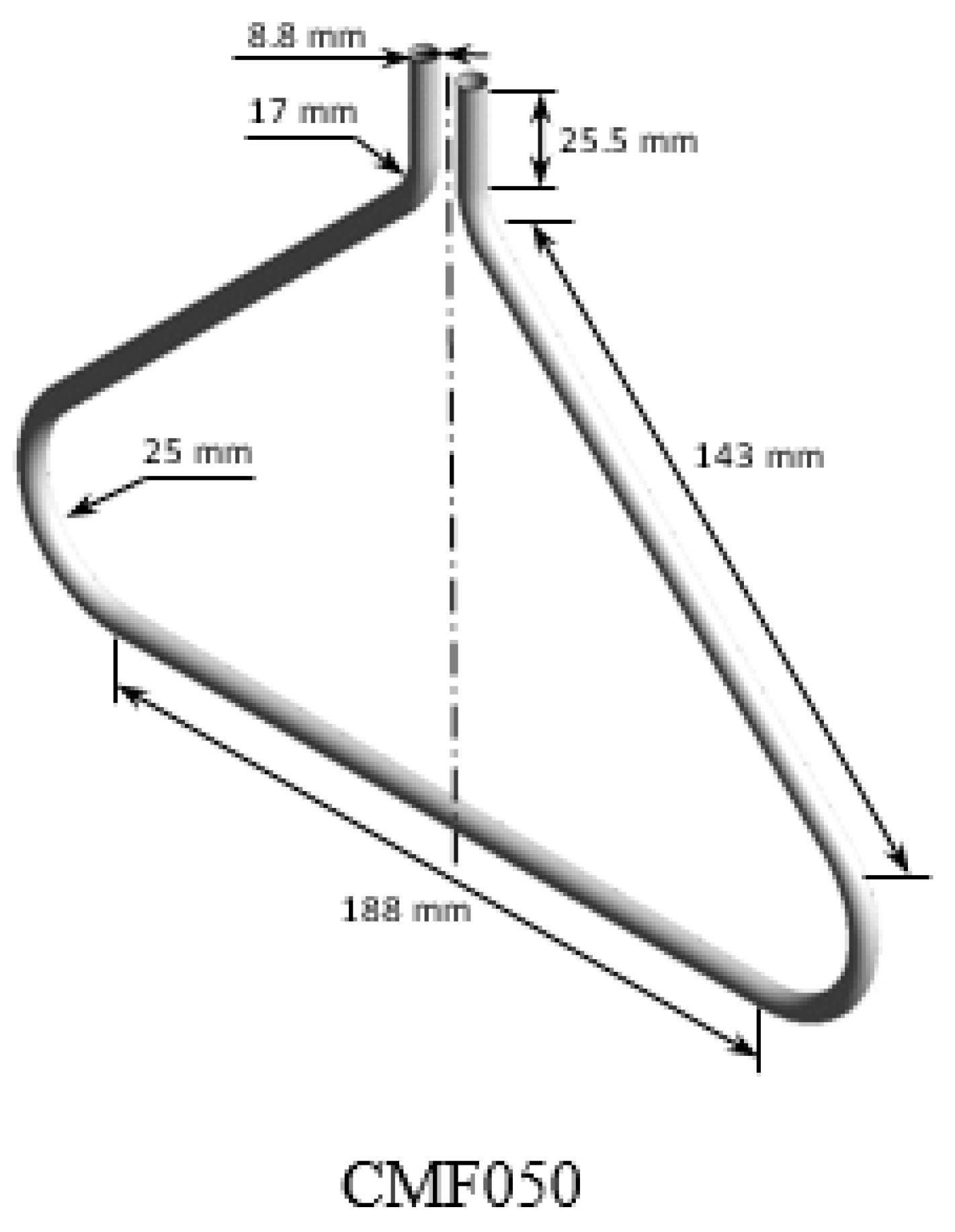
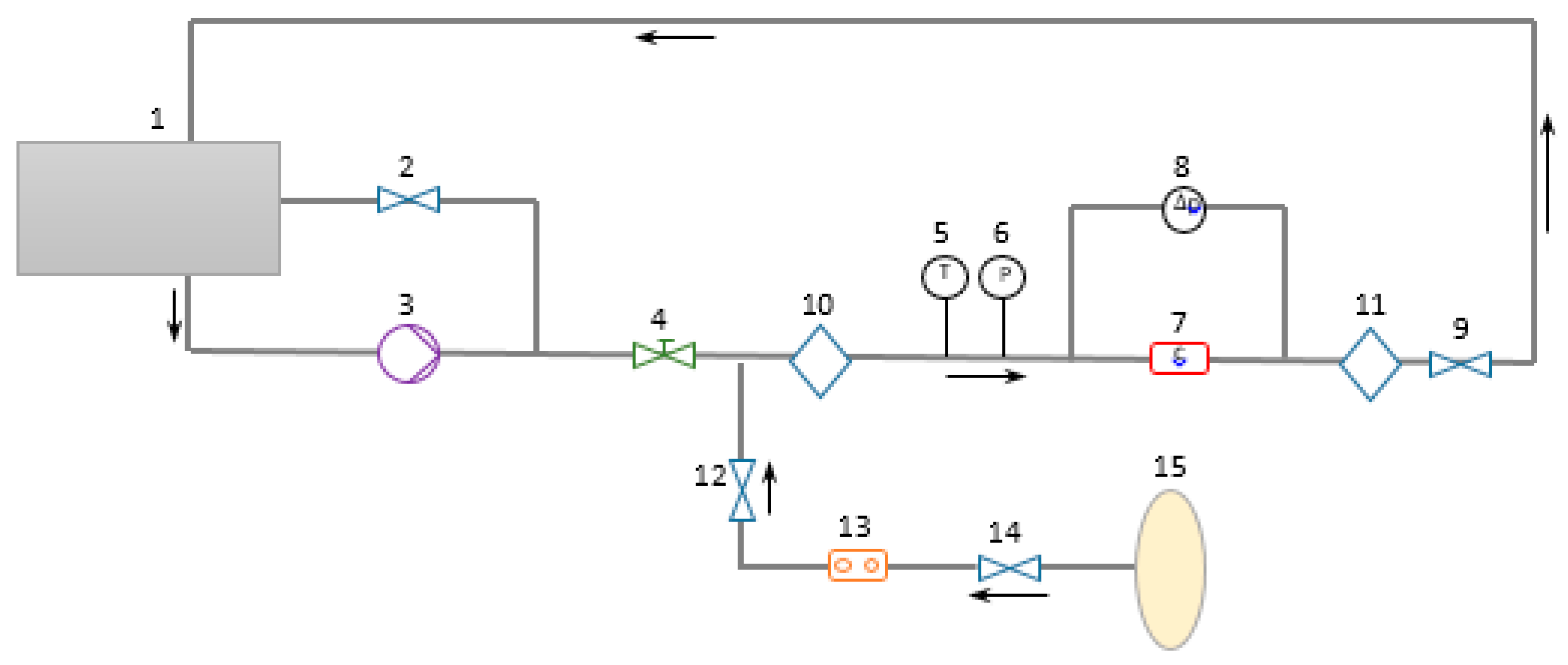


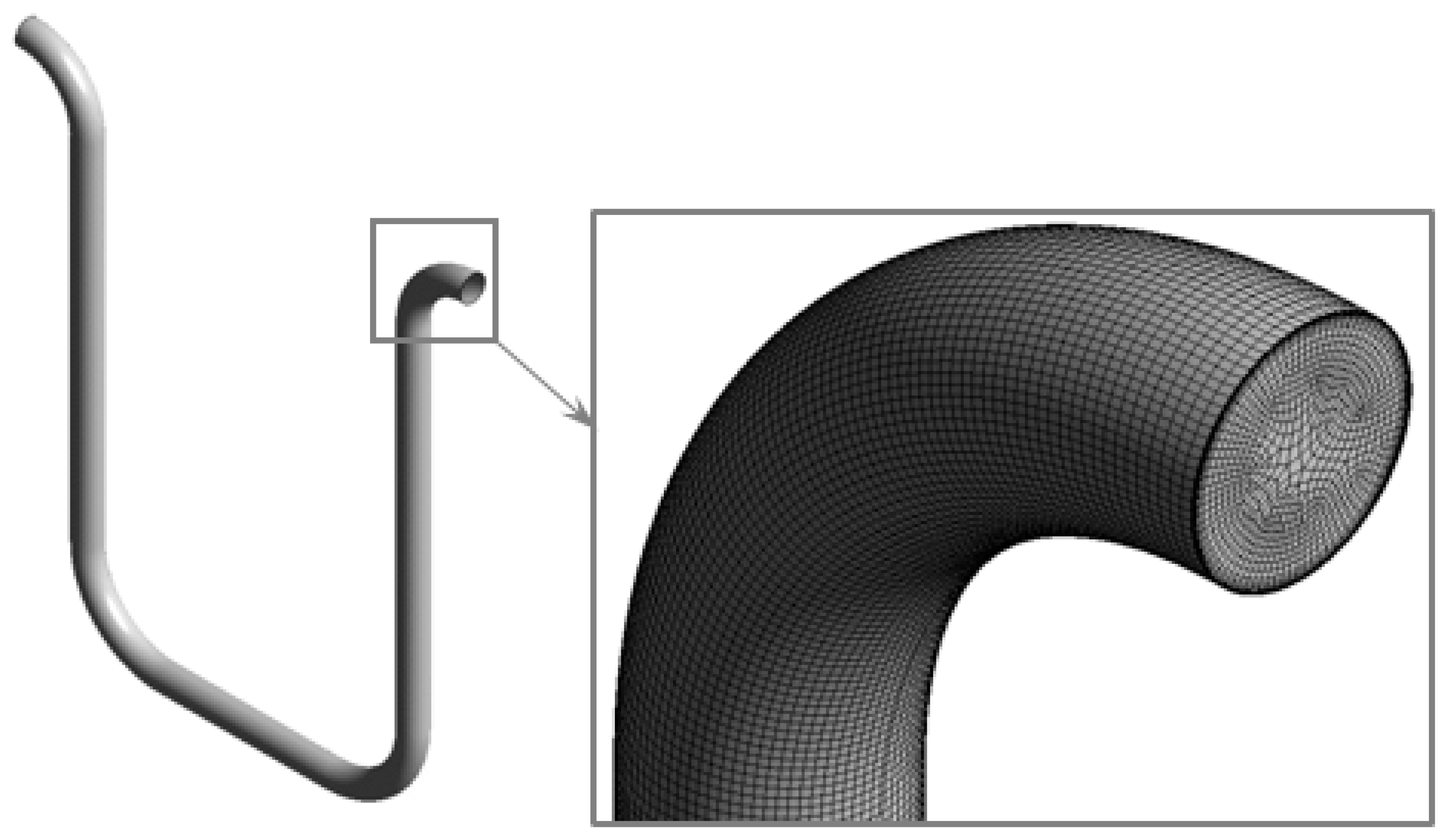
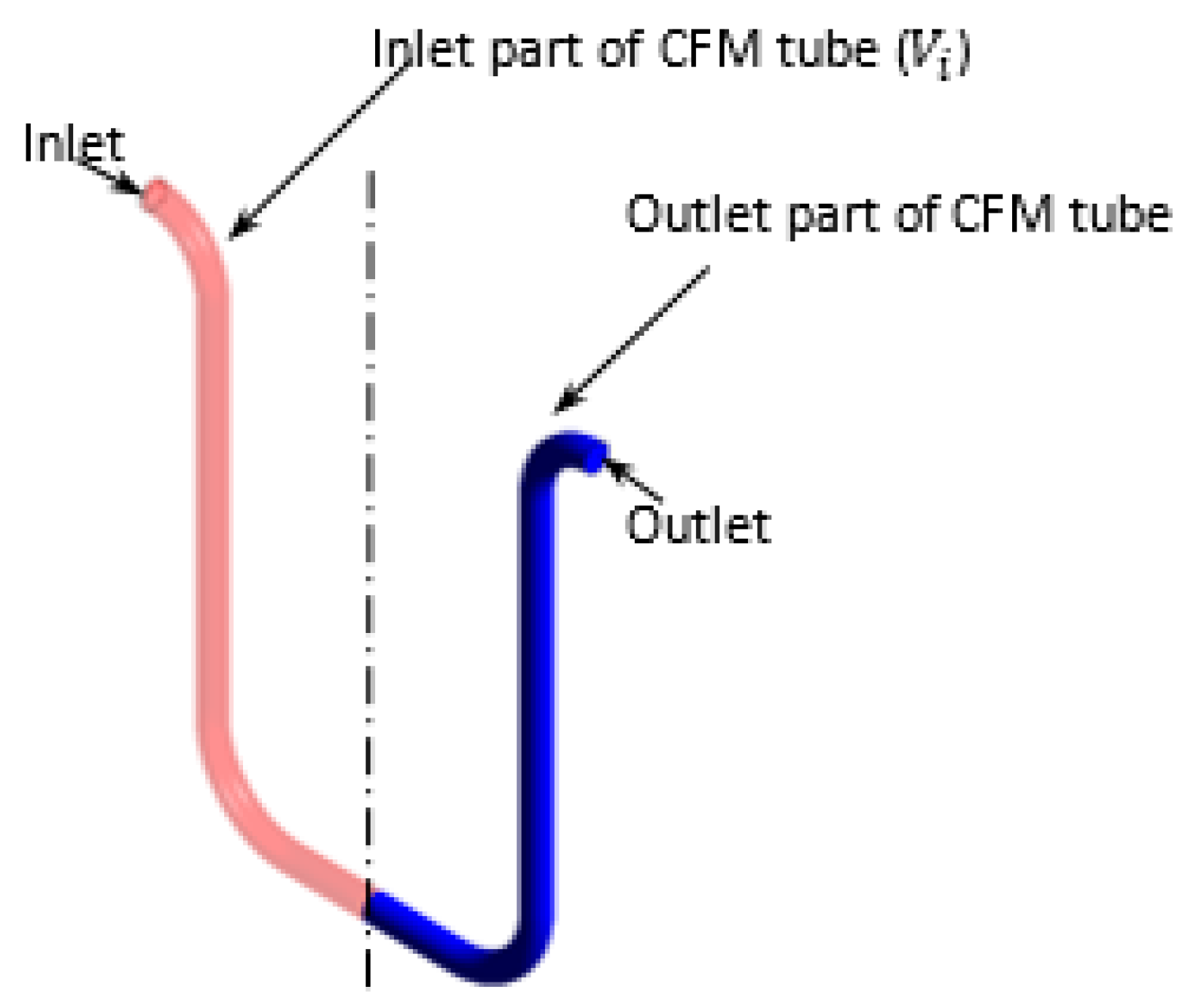
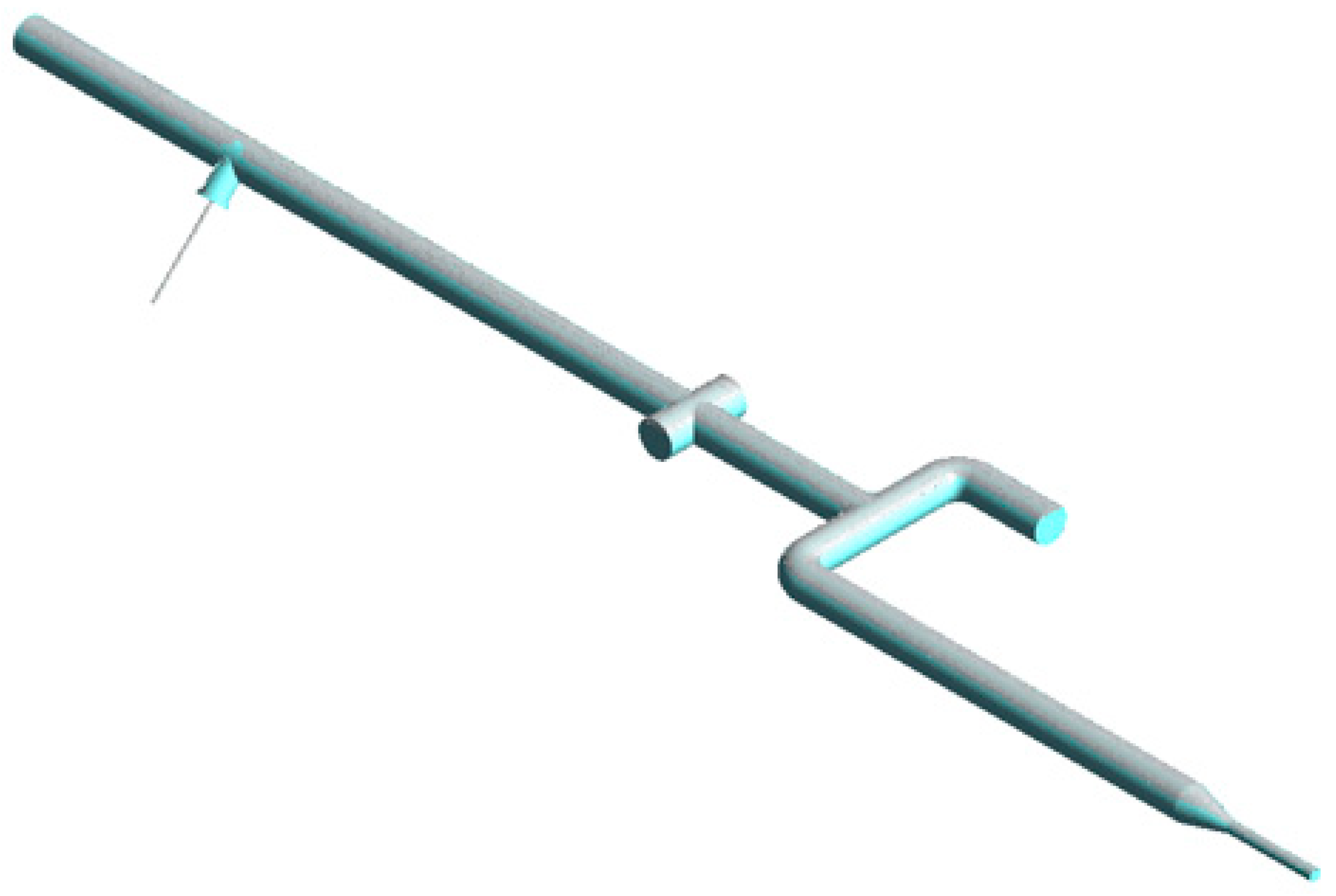
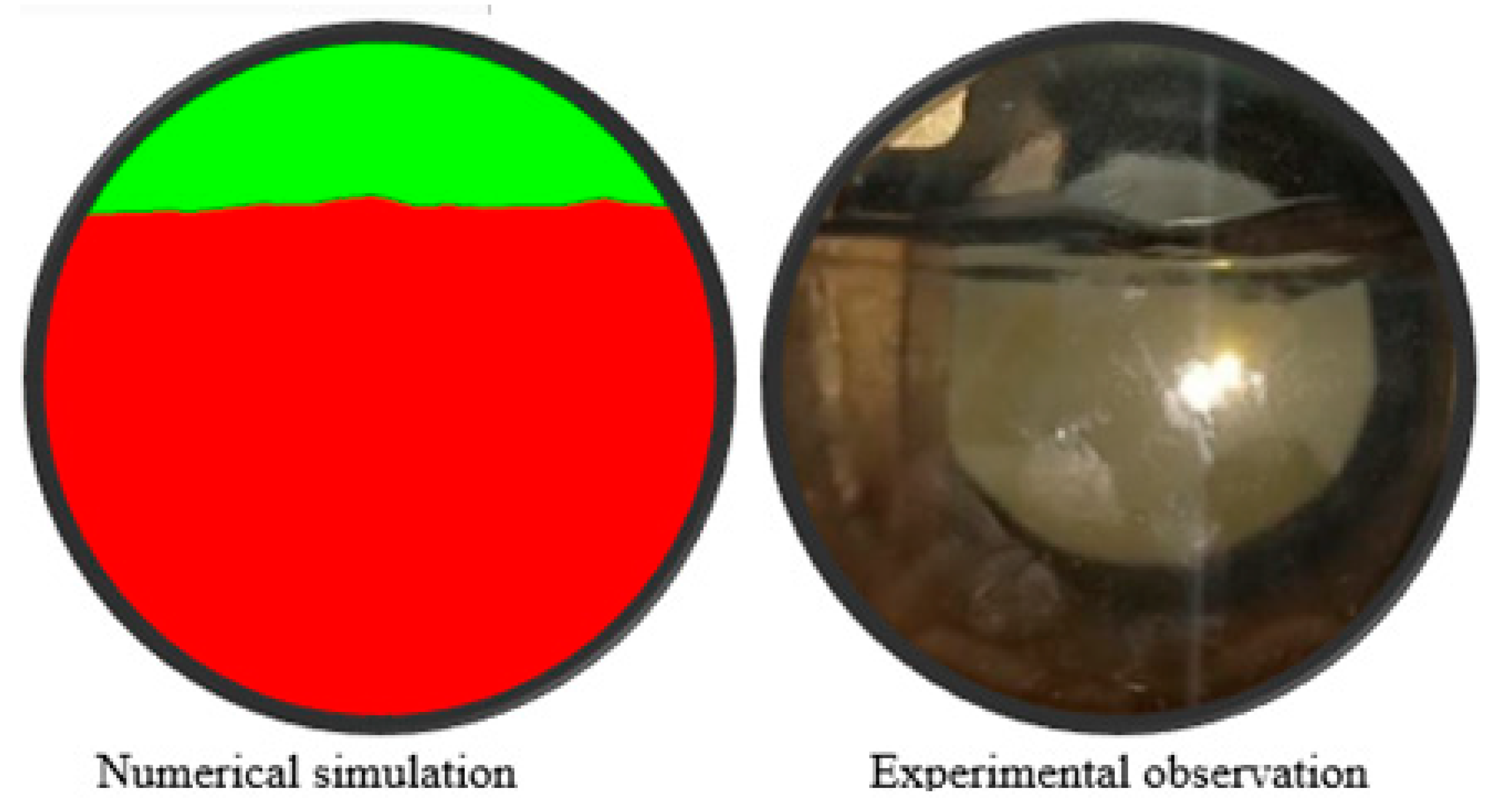



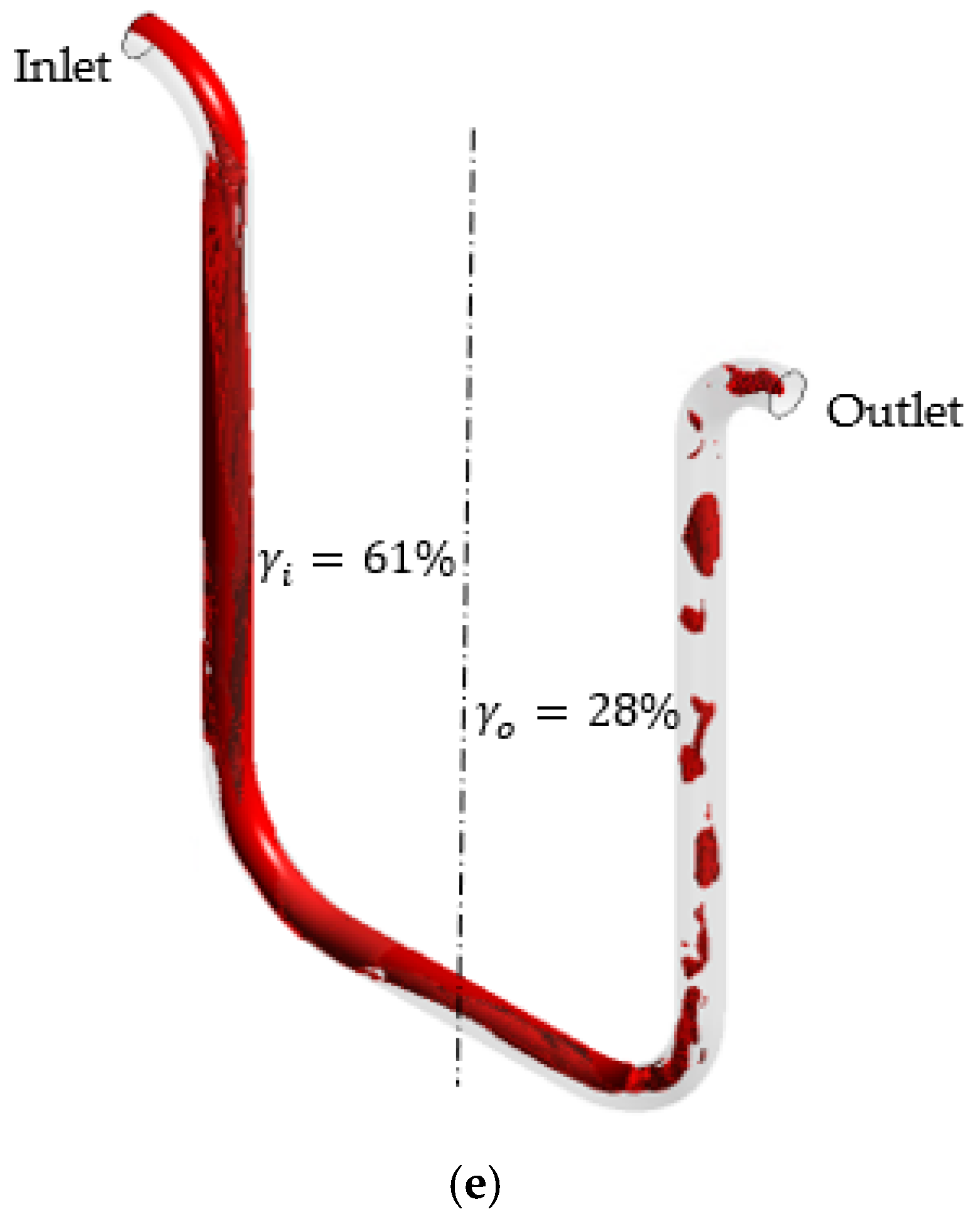
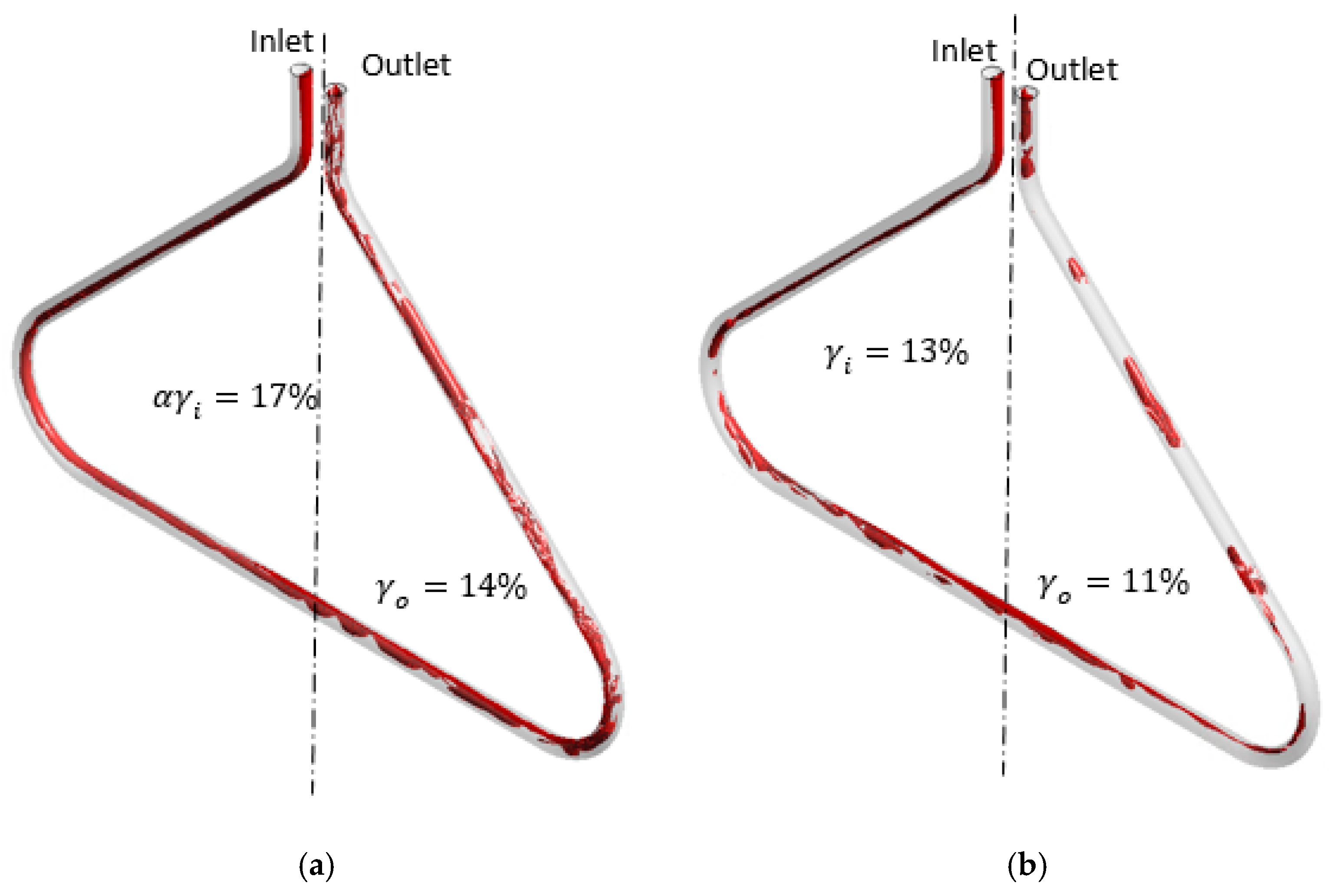


| CFM | Case | Water Flow Rate, kg/min | Gas Flow Rate, L/min | Flow Regime | |
|---|---|---|---|---|---|
| CMF200 | 1 | 60.8 | 12.0 | 16 | Stratified |
| 2 | 9.0 | 13 | |||
| 3 | 6.0 | 9 | |||
| 4 | 100.0 | 19.5 | 16 | ||
| 5 | 149.0 | 15.0 | 9 | Transitional | |
| 6 | 300.0 | 15.0 | 5 | Bubbly | |
| 7 | 26.0 | 8 | |||
| CMF050 | 11 | 40.0 | 7.0 | 15 | Stratified |
| 12 | 4.5 | 10 |
| CFM | Case | Water Flow Rate, kg/min | Flow Regime | |
|---|---|---|---|---|
| CMF200 | 1 | 60.8 | 16 | Stratified |
| 2 | 13 | |||
| 3 | 9 | |||
| 4 | 100.0 | 16 | ||
| 5 | 149.0 | 9 | Transitional | |
| 6 | 300.0 | 5 | Bubbly | |
| 7 | 8 | |||
| D300 | 8 | 182.0 | 8 | Bubbly |
| 9 | 12 | |||
| 10 | 16 | |||
| CMF050 | 11 | 40.0 | 15 | Stratified |
| 12 | 40.0 | 10 |
| Mixture Flow Rate, kg/s | GVF at the Inlet, % | The Bubbles’ Diameter, mm |
|---|---|---|
| 29 | 1.8 | 2.5 (0.02% GVF) |
| 5.3 (0.13% GVF) | ||
| 6.3 (0.71% GVF) | ||
| 8 (0.93% GVF) |
| CFM | Case | ||||||
|---|---|---|---|---|---|---|---|
| CMF200 | 1 | 28 | 0.1 | 38 | −40 | −10 | 68 |
| 2 | 34 | 1.1 | 33 | −30 | −1 | 64 | |
| 3 | 28 | 0.6 | 18 | −20 | 10 | 48 | |
| 4 | 9 | 0.6 | 18 | −40 | −9 | 49 | |
| 5 | −5 | 0.2 | 3 | −20 | −8 | 15 | |
| 6 | −7 | 0.2 | −1 | −11 | −6 | 4 | |
| 7 | −9 | 0.3 | 1 | −17 | −10 | 8 | |
| D300 | 8 | −12 | - | −3 | −17 | −9 | 5 |
| 9 | −14 | - | −4 | −27 | −10 | 13 | |
| 10 | −17 | - | −7 | −38 | −10 | 21 | |
| CMF050 | 11 | 12 | 0.5 | 3 | −35 | 9 | 47 |
| 12 | 5 | 0.8 | 2 | −22 | 3 | 27 |
Publisher’s Note: MDPI stays neutral with regard to jurisdictional claims in published maps and institutional affiliations. |
© 2022 by the authors. Licensee MDPI, Basel, Switzerland. This article is an open access article distributed under the terms and conditions of the Creative Commons Attribution (CC BY) license (https://creativecommons.org/licenses/by/4.0/).
Share and Cite
Shavrina, E.; Zeng, Y.; Khoo, B.C.; Nguyen, V.-T. The Investigation of Gas Distribution Asymmetry Effect on Coriolis Flowmeter Accuracy at Multiphase Metering. Sensors 2022, 22, 7739. https://doi.org/10.3390/s22207739
Shavrina E, Zeng Y, Khoo BC, Nguyen V-T. The Investigation of Gas Distribution Asymmetry Effect on Coriolis Flowmeter Accuracy at Multiphase Metering. Sensors. 2022; 22(20):7739. https://doi.org/10.3390/s22207739
Chicago/Turabian StyleShavrina, Evgeniia, Yan Zeng, Boo Cheong Khoo, and Vinh-Tan Nguyen. 2022. "The Investigation of Gas Distribution Asymmetry Effect on Coriolis Flowmeter Accuracy at Multiphase Metering" Sensors 22, no. 20: 7739. https://doi.org/10.3390/s22207739




